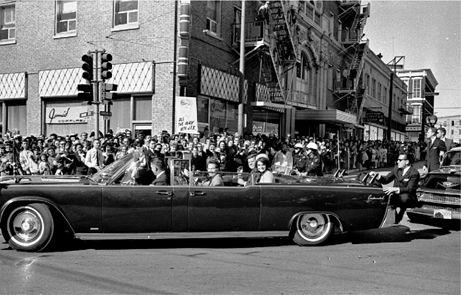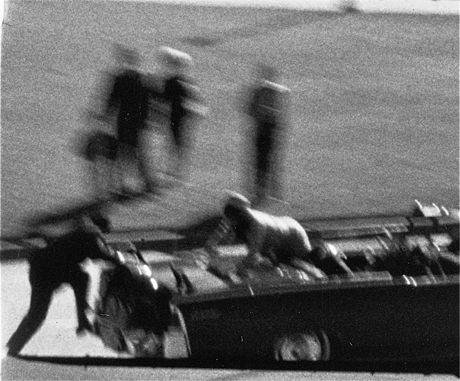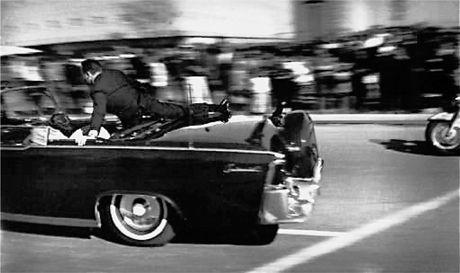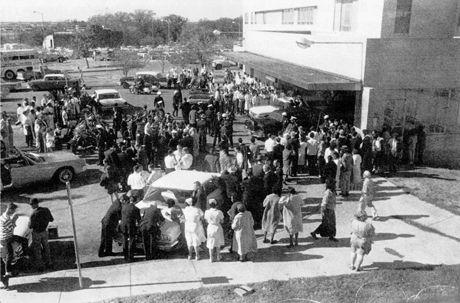Mrs. Kennedy and Me: An Intimate Memoir (49 page)
Read Mrs. Kennedy and Me: An Intimate Memoir Online
Authors: Clint Hill,Lisa McCubbin
Tags: #General, #United States, #Political, #Biography, #History, #Non-Fiction, #Politics, #Biography & Autobiography, #United States - Officials and Employees, #20th century, #Presidents & Heads of State, #Onassis; Jacqueline Kennedy - Friends and Associates, #Hill; Clint, #Presidents' Spouses - Protection - United States, #Presidents' Spouses


Clint Hill crouches on back of limousine on Main Street, Dallas, 11/22/63
I looked back at Halfback, let go of the handhold, jumped off 100X onto the pavement, and in one fluid motion, jumped back to my position on the left running board.
Immediately in front of us as we traveled down Houston Street was a red brick building about seven floors high. Some windows were open in the building, but there was no indication of any problem. Windows had been open all along the route.
We turned left onto Elm Street. It was an unusually sharp turn, and because 100X was no ordinary vehicle, Greer had to slow down considerably. Halfback had similar problems and Kinney maneuvered slowly through the turn.
The vehicles straightened out and began to return to our normal parade pace of about ten miles per hour. I was scanning to the left at the grassy area when I heard a sudden explosive noise, over my right shoulder, from the back of the motorcade.
I turned my head toward the noise, and as my eyes moved across the president’s car, I saw President Kennedy grab at this throat and lurch to his left.
I jumped off the running board and ran toward 100X. I wasn’t thinking, only reacting. Somebody had fired a shot at the president, and I had to get there. I had to get on the car and get myself between the shooter and the president and Mrs. Kennedy.
I was running as fast as I could. Nothing else mattered.
I have been told there was a second shot, which occurred at this time. I did not hear it. My feet were hitting the pavement; the motorcycle engines were loud in my ears.
I’m almost there. Mrs. Kennedy is leaning toward the president. I’m almost there.
I was almost there. And then I heard the shot. The third shot. The impact was like the sound of something hard hitting something hollow—like the sound of a melon shattering onto cement. In the same instant, blood, brain matter, and bone fragments exploded from the back of the president’s head. The president’s blood, parts of his skull, bits of his brain were splattered all over me—on my face, my clothes, in my hair.
My legs were still moving. I assumed more shots were coming. I reached for the handhold and grabbed it.
Just as I grabbed it, the car lurched forward. Bill Greer had stepped on the gas, and the car reacted with a jolt. I slipped. I was gripping with all my strength, my feet now back on the pavement. My legs kept moving, as I held on, trying to keep up with the rapidly accelerating car. Somehow—I honestly don’t know how—I lunged and pulled my body onto the car, and my foot found the step. In that same instant, Mrs. Kennedy rose up out of her seat and started climbing onto the trunk.
What is she doing? What is she doing?

The car was accelerating—we were really speeding up.
Good God, she’s going to go flying off the back of the car!
Her eyes were filled with terror. She didn’t even know I was there. She was reaching for something. She was reaching for a piece of the president’s head.
I thrust myself onto the trunk, grabbed her arm, and pushed her back into the seat.
When I did this, the president’s body fell to the left onto her lap.
As I peered into the backseat of the car, I saw the president’s head, in her lap. His eyes were fixed, and I could see inside the back of his head. I could see inside the back of the president’s head.
“My God! They have shot his head off!” Mrs. Kennedy screamed.
Blood was everywhere. The floor was covered in blood and brain tissue and skull fragments.
“Get us to a hospital! Get us to a hospital!” I screamed at Bill Greer.
I wedged myself between the left and right side of the vehicle, on top of the rear seat, trying to keep my body as high as possible to shield whatever shots might still be coming. I had my left hand on the top of the left door frame and
my left foot wedged against the inside of the right frame, my right foot hanging over the top of the car frame on the right.
I twisted around to make eye contact with the follow-up car. They had to know how bad it was. With my one free hand, I gave them the thumbs-down sign and shook my head.
My head turned back to the gruesome scene in the car. Nellie Connally was hunched over the governor. And Mrs. Kennedy had her husband’s head in her lap.
“Jack, Jack, what have they done to you?”
Thoughts swirled in my head.
Will we get there in time? Go faster, go faster! He’s not breathing. Hang on Mr. President. Hang on. My God, what more can happen to her?
And then came the thought that haunts me still:
How did I let this happen to her?
C
HIEF
C
URRY, DRIVING
the lead car, had slowed down to see what happened.
“Take me to the hospital, quick!” Bill Greer yelled.
Curry immediately sped up and got in front of us. We were now traveling on a multilane freeway going very fast. Sixty, seventy, eighty miles an hour. Still wedged up high, I was holding on with every ounce of strength in my arms and legs.

I turned my head and my sunglasses blew off.
Governor Connally lifted up and I realized for the first time that he also had been shot.
All time had stopped. It took an eternity to get to the hospital. Finally, we pulled up to the emergency section of a hospital. The sign said:
PARKLAND MEMORIAL HOSPITAL
.
It was 12:34, four minutes since the first shot rang out in Dealey Plaza. An eternity.
Sam Kinney had stayed right behind us the entire way. When the cars stopped everyone raced to the presidential car. Emory Roberts took one look at the condition of President Kennedy and said, “I’m taking my men to Johnson.”
Everyone knew it was the right thing to do. The agents in the follow-up car had seen the impact.
Agent Lawson had run into the emergency room to get help and gurneys because no one was outside to assist us. He came out with two gurneys and an orderly. The first thing we had to do was remove Governor Connally from the car. We couldn’t move the president until the jump seat was folded up.
We got the governor on a gurney and he was taken inside. Mrs. Connally had remained amazingly composed, and went inside the hospital with her husband.
Mrs. Kennedy had not moved. She was holding on to the president, his head still in her lap.
“Mrs. Kennedy,” I said. “Please let us help the president.”
She would not let go.
“Please Mrs. Kennedy,” I pleaded. “Please let us get him into the hospital.”
She looked up at me. She was in shock. Her eyes were looking, but not seeing. And then I understood:
She doesn’t want anyone to see him like this. Nobody should see the president like this. I understand, Mrs. Kennedy. You’re right. Nobody should see the president like this.
I took off my suit coat and placed it over his head and upper torso.
Now no one will see him, Mrs. Kennedy. It’s okay now.
She still hadn’t said a word, but as soon as my coat was covering the president, she released her grip.
Together, Agents Win Lawson, Roy Kellerman, Dave Powers, and I lifted the president’s lifeless body onto the gurney.
Three shots had been fired in Dealey Plaza. And the world stopped for four days.
Parkland Hospital

D
octors and nurses were everywhere—it was a blur of white coats—as we passed Trauma Room No. 2, where Governor Connally had been taken, and wheeled the president into Trauma Room No. 1. Mrs. Kennedy was holding on to the gurney, staring at her husband’s body, my coat still over his head and torso.
As someone reached to pull my coat off, I grabbed her firmly by the arm and said, “Mrs. Kennedy, let’s go wait outside.”
“No,” she said. “I’m staying in here with him.”
“Clint,” Roy Kellerman interrupted, “contact the White House. And keep the line open.”
I looked at Mrs. Kennedy, not wanting to leave her, but Kellerman was right. We had to let the White House know what had happened.
Paul Landis stood outside the door of the trauma room, while I found a telephone and dialed the number for the special switchboard in Dallas that would get me straight to the White House.
“This is Clint Hill. Give me Jerry Behn’s office in Washington and keep this line open.”
Just as Jerry Behn, the Special Agent in Charge of the White House Detail, answered, Roy Kellerman came out of the trauma room and grabbed the phone.
As Kellerman began to explain the horror of what had happened less than ten minutes before, a medic rushed out of the trauma room.
“Does anybody know the president’s blood type?”
“O. R-H positive,” Kellerman blurted out.
Just then, Mrs. Kennedy came out of the trauma room. Her face, still spattered with blood, was expressionless.
I strode over to her, afraid she might faint.
Landis called out, “Somebody get a chair for Mrs. Kennedy.”
There were agents and medical staff and policemen all over the place. People running around back and forth, in and out of the two trauma rooms. Somebody brought a chair and I said, “Mrs. Kennedy, sit down.”
